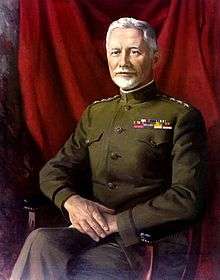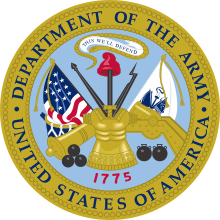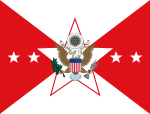Peyton C. March
| Peyton Conway March | |
|---|---|
 | |
| Chief of Staff of the United States Army | |
|
In office 1918–1921 | |
| Appointed by | Woodrow Wilson |
| Preceded by | Tasker Howard Bliss |
| Succeeded by | John J. Pershing |
| Personal details | |
| Born |
December 27, 1864 Easton, Pennsylvania |
| Died |
April 13, 1955 (aged 90) Walter Reed Army Medical Center, Washington, D.C |
| Alma mater | Lafayette College |
| Awards |
Distinguished Service Cross Distinguished Service Medal Silver Star Legion of Honor (France) |
| Military service | |
| Allegiance |
|
| Service/branch |
|
| Years of service | 1888–1921 |
| Rank |
|
| Commands |
Astor Battery 19th Field Artillery Battery 1st Battalion, 6th Field Artillery 8th Field Artillery Regiment 1st Field Artillery Brigade, 1st Division First United States Army Artillery Chief of Staff of the United States Army |
| Battles/wars |
Spanish–American War Philippine–American War Pancho Villa Expedition World War I Russian Civil War |
Peyton Conway March (December 27, 1864 – April 13, 1955) was an American soldier and Army Chief of Staff. He is largely responsible for the designing the powerful role of the Chief of Staff in the 20th century.
Early life and education
He was born December 27, 1864 in Easton, Pennsylvania to Francis Andrew March, His father was the principal founder of modern comparative linguistics in Anglo-Saxon. His mother descended from Thomas Stone, a signer of the Declaration of Independence, and was Moncure D. Conway's sister.[1]
Peyton March attended Lafayette College, where his father occupied the first chair of English language and comparative philology in the United States.[2] While at Lafayette College, March was a member of the Rho Chapter of Delta Kappa Epsilon. After graduating with honors in 1884,[3] he was appointed to West Point and graduated in 1888, ranked 10th in a class of 44.[2]
Early Army career
.jpg)
After his initial assignment to the 3rd Artillery, March was assigned to the 5th Artillery as a 1st lieutenant in 1894. He was sent to the Artillery School at Fort Monroe, Virginia in September 1896 and graduated in April 1898, at the outbreak of the Spanish–American War. As he was not immediately assigned, he watched as his classmates went off to various commands, and began fearing he would not see combat. In early May, that changed when he was offered to lead what later became known as the Astor Battery, named so because it was personally financed by John Jacob Astor IV. He organized, equipped and subsequently commanded the battery when it was sent to the Philippines during the Spanish–American War.[4] Historian Bruce Campbell Adamson has written about Henry Bidwell Ely (Adamson's great grandfather) who was placed in charge of The Astor Battery by John Jacob Astor IV, to give Peyton March whatever he needed. March credited Ely as having "an open check book" to purchase uniforms, mules and the cannons.[5]
After the battery returned from the Philippines in 1899, March was assigned as the aide to Major General Arthur MacArthur, Jr. during the Philippine–American War. Later that year he was promoted to major. He continued to serve in the Philippines, participated as part of General Loyd Wheaton's expedition in battles at San Fabian, Buntayan Bridge and San Jacinto. He commanded the U.S. forces in the Battle of Tirad Pass, 2 December 1899, where General Gregorio del Pilar was killed, and received the surrender of General Venacio Concepción, Chief of Staff to Philippine President Aguinaldo at Cayan, 5 December 1899. He served as provincial governor of districts including Lepanto-Bontoc and Ilocos Sur from February to June 1900, and then the Abra Province from June 1900 to February 1901. He then served as Commissary General of Prisoners for the Philippine Islands through 30 June 1901, when he mustered out of the U.S. Volunteers.[6]
In 1903, he was sent to Fort Riley and commanded the 19th Battery of the Field Artillery. Later that year, he was sent to Washington, D.C. and served on the newly created General Staff.
From 21 March to 30 November 1904, March was one of several American military attachés serving with the Imperial Japanese Army in the Russo-Japanese War.[2] Of the seventeen military attachés observing both sides of the Russo-Japanese War for the United States, eight were later promoted to be generals.[7]
In 1907, March commanded the 1st Battalion, 6th Field Artillery. March then served as adjutant of Fort Riley, Kansas and then served as adjutant at several other commands, including at the War Department.
In 1916, he was promoted to colonel and commanded the 8th Field Artillery Regiment on the Mexican border during the Pancho Villa Expedition.
World War I
In June 1917, March was promoted to brigadier general and commanded the 1st Field Artillery Brigade, 1st Division, American Expeditionary Forces. Later that year, he was promoted to major general and commanded the artillery units of the First United States Army and all non-divisional artillery units.[2]
In March 1918, he was recalled to Washington, took over as acting Army Chief of Staff on March 4 and was Army Chief of Staff on May 20, 1918. He was promoted to temporary general.

March was highly critical of President Wilson's decision to send an American Expedition to North Russia and Siberia in 1918 during the Russian Civil War (the so-called Siberian Intervention) ostensibly to prop-up the White movement war effort, secure the railroads, support the Czech Legion trapped there, and stop the Japanese from exploiting the chaos in order to colonize Siberia. March wrote after the pull-out of American forces in 1920:
| “ | The sending of this expedition was the last occasion in which the president reversed the recommendation of the War Department during my service as Chief of Staff of the Army. ... almost immediately after the Siberian and North Russian forces had reached their theaters of operations, events moved rapidly and uniformly in the direction of complete failure of these expeditions to accomplish anything that their sponsors had claimed for them.[8] | ” |
In 1919, March was admitted as an honorary member of the Virginia Society of the Cincinnati.

He served as Chief of Staff until June 30, 1921. As Chief of Staff he reorganized the Army structure, and abolished the distinctions between the Regular Army, the Army Reserves, and the Army National Guard during wartime. He created new technical branches in the service including the United States Army Air Corps, Chemical Warfare Service, Transportation Corps, and Tank Corps. He also centralized control over supply. After the war ended, he supervised the demobilization of the Army. As Chief of Staff he often came into disagreement with General John J. Pershing, who wanted to conduct the AEF as an independent command. March was a highly efficient and capable administrator who did much to modernize the American Army and prepare it for combat in the First World War.
Retirement
March retired as a major general in 1921.[9] In June 1930, March was advanced to general on the retired list.
In December 1922, March was elected honorary president of Delta Kappa Epsilon during the fraternity's 78th Annual Convention.[10]
After retirement, he travelled Europe, Africa and Turkey.[11] In 1932, he published his war memoirs, The Nation at War.[12] During World War II, reporters for Time and Life magazines regularly sought his opinions of events.[11]
Death and burial
March died at the Walter Reed Army Medical Center on April 13, 1955[13] and was buried at Arlington National Cemetery.
In his funeral marched "the escort commander and his staff; the U.S. Army Band; one battalion of cadets from the US Military Academy; one company of infantry; one battery of field artillery; one company of armor; the U.S. Marine Band; one company of Marines; one company of bluejackets; one squadron of airmen; and one composite company of servicewomen." The estimated total strength of the military escort was 1,200 soldiers, sailors, airmen and Marines.
At the grave "was a large group of military, civilian, and foreign dignitaries headed by Vice President Richard M. Nixon. Also in attendance were representatives of the Society of the Cincinnati, the Descendants of the Signers of the Declaration of Independence, and the Delta Kappa Epsilon Fraternity, to all of which General March had belonged."[14]
Family
He married Josephine Cunningham (née Smith, 18 December 1862 – 18 November 1904), the widowed daughter[11] of his battery commander, Lieutenant Colonel Lewis Smith,[15] on July 4, 1891. She died in November 1904, while March was still observing the Imperial Japanese Army.[2] Between 28 November 1917 and 8 June 1918, their daughters Mildred (1893—1967), Josephine (1895—1972) and Vivian (1899—1932) had all married Army officers.[16] Josephine had a twin brother, named Peyton Jr. who died ten days after their birth. March's second son, also named Peyton, Jr., was killed in a plane crash in Texas during World War I. March AFB in Riverside, California was named in young March's honor.[17] A third son, Lewis Alden March, was born in 1904 and died in 1928.[11][18]
While traveling in Italy, he met Cora Virginia McEntee (1897–1964), and married her in August 1923.[11][18][19]
Dates of rank
| Insignia | Rank | Component | Date |
|---|---|---|---|
| None | Cadet | United States Military Academy | 15 June 1884 |
| None in 1888 | Second Lieutenant | Regular Army | 11 June 1888 |
| First Lieutenant | Regular Army | 25 March 1894 | |
| Major | Volunteers | 5 July 1899 | |
| Lieutenant Colonel | Volunteers | 9 June 1900 | |
| Captain | Regular Army | 2 February 1901 (Discharged from Volunteers on 30 June 1901.) | |
| Major | Regular Army | 25 January 1907 | |
| Lieutenant Colonel | Regular Army | 8 February 1912 | |
| Colonel | Regular Army | 1 July 1916 | |
| Brigadier General | Regular Army | 17 June 1917 | |
| Major General | National Army | 5 August 1917 | |
| Major General | Regular Army | 12 February 1918 | |
| General | Emergency | 20 May 1918 | |
| Major General | Regular Army | 1 July 1920 | |
| Major General | Retired List | 1 November 1921 | |
| General | Retired List | 21 June 1930 |
Source: Army Register, 1946[20]
Awards and decorations
-
 Distinguished Service Cross[21]
Distinguished Service Cross[21] -
 Army Distinguished Service Medal[21]
Army Distinguished Service Medal[21] -
 Silver Star with four oak leaf clusters[21]
Silver Star with four oak leaf clusters[21] -
 Spanish Campaign Medal
Spanish Campaign Medal -
 Philippine Campaign Medal
Philippine Campaign Medal -
 Mexican Border Service Medal
Mexican Border Service Medal -
 World War I Victory Medal
World War I Victory Medal -
 Honorary Knight Grand Cross of the Order of St Michael and St George (UK)
Honorary Knight Grand Cross of the Order of St Michael and St George (UK) -
 Grand Officier Légion d'honneur (France)
Grand Officier Légion d'honneur (France) -
 Grand Cross Order of Saints Maurice and Lazarus (Italy)
Grand Cross Order of Saints Maurice and Lazarus (Italy) -
 Grand Cordon Order of the Rising Sun (Japan)
Grand Cordon Order of the Rising Sun (Japan) -
 Grand Cross Order of George I (Greece)
Grand Cross Order of George I (Greece) -
 Grand Cross Order of the Crown (Belgium)
Grand Cross Order of the Crown (Belgium) -
 Grand Cross Polonia Restituta (Poland)
Grand Cross Polonia Restituta (Poland) -
 War Cross (Czechoslovakia)
War Cross (Czechoslovakia)
| Wikimedia Commons has media related to Peyton C. March. |
See also
- Battle of Tirad Pass
-
 Biography portal
Biography portal -
 United States Army portal
United States Army portal -
.jpg) World War I portal
World War I portal
References
- ↑ "March, Peyton Conway (1864 - 1955), Army Officers (1866–1995)". Oxford Index. Oxford University Press. Retrieved 15 May 2015.
- 1 2 3 4 5 Davis, Jr., Henry Blaine (1998). Generals in Khaki. Raleigh, NC: Pentland Press, Inc. p. 242. ISBN 1571970886.
- ↑ Delta Kappa Epsilon Council (1910). Warren, Aldice G., ed. Catalogue of the Delta Kappa Epsilon Fraternity. Philadelphia: John C. Winston Company. p. 742. Retrieved 15 May 2015.
- ↑ Feuer, A.B., ed. (2002). "11". America at War: The Philippines, 1898–1913 ([Online-Ausg.] ed.). Westport, Conn.: Praeger Publishers. pp. 65–72. ISBN 9780275968212. Retrieved 15 May 2015.
- ↑ Adamson, Bruce Campbell (1996). Potter, Agnes H.; Ely, George W.; Hawkins, William D., eds. The Life and Times of Captain George W. Ely, 1840–1922: Secretary of the New York Stock Exchange, 1874–1919. Aptos, California: Bruce Campbell Adamson. ISBN 9781892501011.
- ↑ Cullum, George Washington (1920). Braden, Lieutenant Charles, ed. Biographical Register of the Officers and Graduates of the U.S. Military Academy, at West Point, N.Y., since its Establishment in 1802: Supplement V, 1900–1910. Saginaw, Michigan: Houghton, Mifflin. p. 418. Retrieved September 5, 2015.
- ↑ Sisemore, James D. (2003). The Russo-Japanese War, lessons not learned. Fort Leavenworth, Kansas: U.S. Army Command and General Staff College. pp. 2, 109. ISBN 9781497522282. Retrieved 15 May 2015.
- ↑ Willett, Robert L. (2003). Russian sideshow : America's undeclared war 1918-1920 (1st ed.). Washington, DC: Brassey's. p. 264. ISBN 9781574884296.
- ↑
 Chisholm, Hugh, ed. (1922). "March, Francis Andrew". Encyclopædia Britannica (12th ed.). London & New York.
Chisholm, Hugh, ed. (1922). "March, Francis Andrew". Encyclopædia Britannica (12th ed.). London & New York. - ↑ "Delta Kappa Epsilon Honors Unknown Here". Evening Star. Washington, D.C. 29 December 1922. p. 9.
- 1 2 3 4 5 Glenn, Justin (2014). The Washingtons: A Family History: Volume 5 (Part One): Generation Nine of the Presidential Branch. California: Savas Publishing. p. 535. ISBN 9781940669304. Retrieved 15 May 2015.
- ↑ March, Peyton C. (1932). The Nation at War. Garden City, NY: Doubleday, Doran & Company, Inc. ISBN 9781430476542.
- ↑ Davis, Jr., Henry Blaine (1998). Generals in Khaki. Raleigh, NC: Pentland Press, Inc. pp. 242–243. ISBN 1571970886.
- ↑ Mossman, Billy C.; Stark, M. Warner (1972). The Last Salute: Civil and Military Funerals, 1921-1969. Washington, DC: Government Printing Office. pp. 81–86.
- ↑ "Tribute Paid at Bier of a Gallant Soldier". The San Francisco Call. San Francisco, California. 25 April 1907. p. 2. Retrieved 15 May 2015.
- ↑ "Maj. Gen. March's Three Daughters All War Brides". The Evening World. New York, N.Y. 16 May 1918. p. 18. Retrieved 15 May 2015.
- ↑ Armed Services Press, Welcome to March Air Force Base – 1971 Unofficial Guide and Directory, Riverside, California, 1971, page 3.
- 1 2 papers, compiled from family; Anderson, from reliable sources by Sarah Travers Lewis Scott (1984). Lewises, Meriwethers and their Kin: Lewises and Meriwethers with Their Tracings through the Families Whose Records Are Herein Contained. Baltimore: Genealogical Pub. Co. p. 488. ISBN 9780806310725. Retrieved 15 May 2015.
- ↑ "General March has taken young bride". Berkeley Daily Gazette. Berkeley, California. 25 August 1923. p. 9. Retrieved 15 May 2015.
- ↑ The Adjutant General's Office, War Department (1946). Official Army Register for 1946 (PDF). Washington, D.C.: Government Printing Office. p. 963. Retrieved September 5, 2015.
- 1 2 3 "Valor awards for Peyton Conway March".
Further reading
- Coffman, Edward M. (1966). The Hilt of the Sword: The Career of Peyton C. March. Madison, Wisconsin: University of Wisconsin Press. OCLC 289059.
- Neumann, Brian (October 2009). "A Question of Authority: Reassessing the March-Pershing "Feud" in the First World War" (PDF). The Journal of Military History. 73 (4): 1117–1142.
- Fisher, Ann (5 February 1973). Toward a Post World War I Military Policy: Peyton C. March vs. John McAuley Palmer (PDF). Carlisle Barracks, Pennsylvania: U.S. Army War College.
- Browne, B. F., Brigadier General, U.S. Army (Retired) U.S.M.A. 1901. "Peyton C. March, 1888". Memorials. West Point Association of Graduates.
External links
| Military offices | ||
|---|---|---|
| Preceded by Tasker H. Bliss |
Chief of Staff of the United States Army 1918–1921 |
Succeeded by John J. Pershing |

